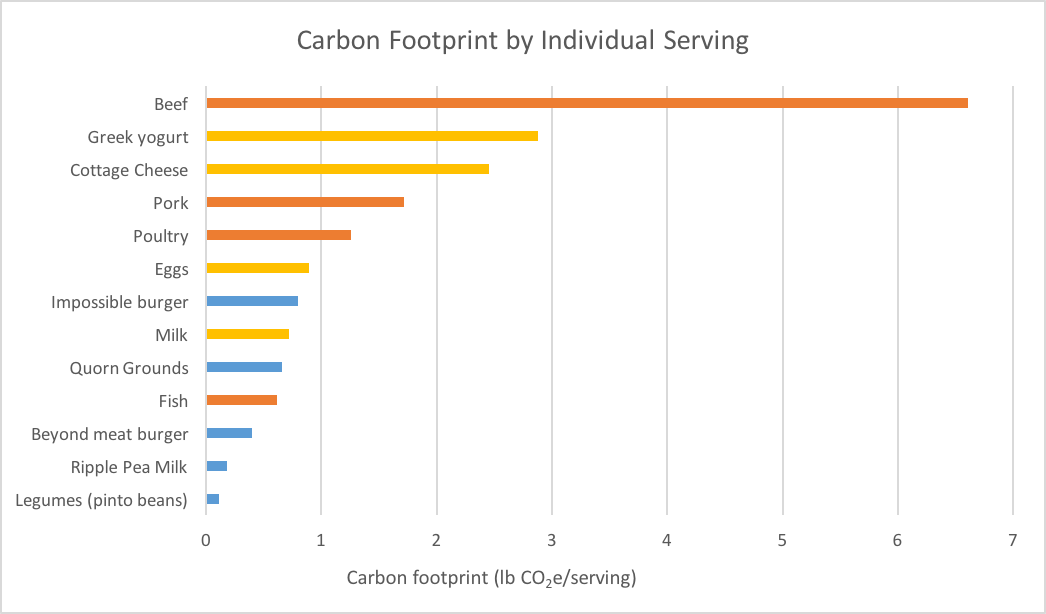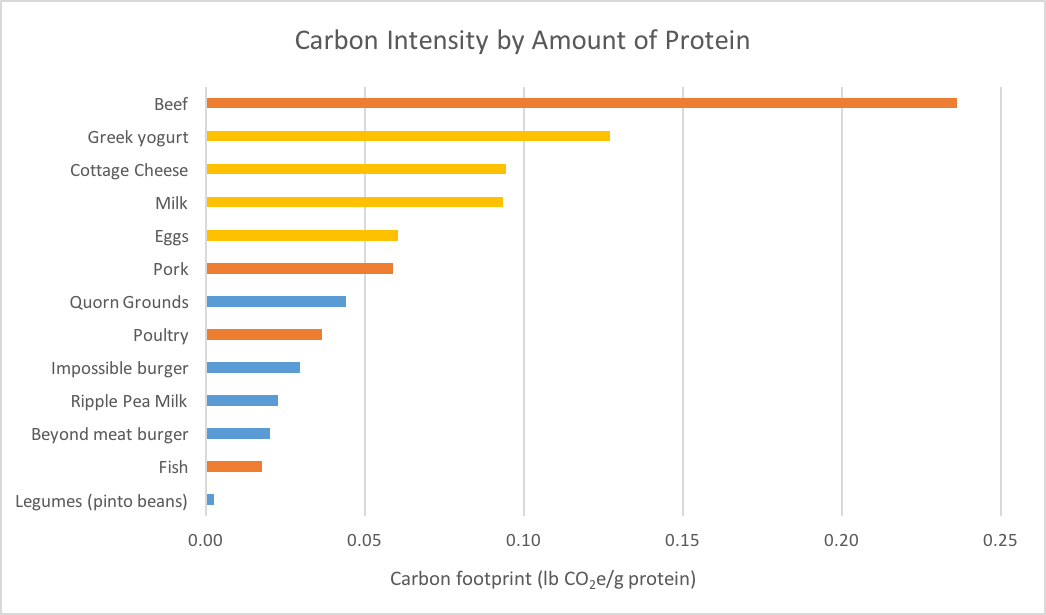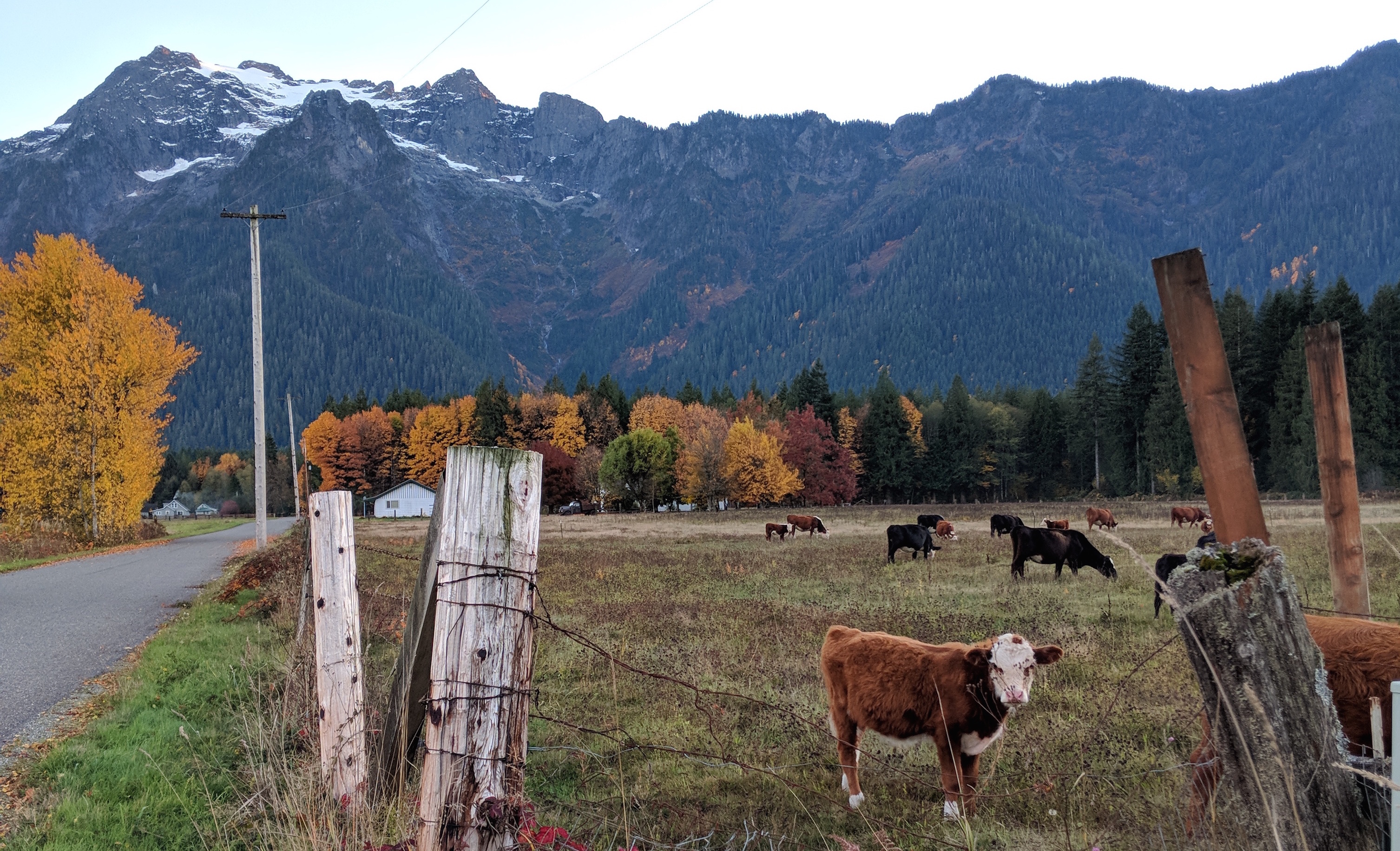The Caloric Intermediary: The Carbon Footprint of Protein in a Diet
Food: It is our body’s fuel. We need it to think and move. We need it to create ideas, and accomplish athletic feats, plus it tastes good. It is what sustains us, and it contributes to our overall, lifelong health. But making food decisions is often fraught. Choose the healthiest option? Choose my favorite option, even if it is not the best for me? From a young age, many of us do not care for fruits and vegetables, particularly when faced with other, much tastier options. Children are far more sensitive to taste and texture, and preferences created in our youth can spill over into adulthood.
As we age, we may become more adventurous, trying new flavors and preparations of the foods we previously detested. We may even find we quite like the broccoli prepared with garlic, or the brussel sprouts in mustard. The next hurdle becomes reproducing recipes at home. Whether this challenge is real or imagined, the friction of purchasing fresh food, using it before it goes bad, and having all the correct ingredients makes cooking for ourselves seem arduous, especially after a long days’ work.
Hard decisions
Now on top of the daily decisions we make in determining what we use to fuel ourselves, there is a rapidly growing body of information attempting to educate us on the broader impacts of our nutrition decisions. Recent droughts in California brought to light the high water demands of almonds. Overfishing has led to concerns about entire marine ecosystem disruption. And, perhaps most thoroughly-communicated, is the impact of beef production, or, really, cow burping, on our global carbon footprint. As the world becomes wealthier, more people fill their plates with more complex proteins, increasing global demand for animal products.
Researchers argue that animals converting plants into calories for human consumption is extremely inefficient. The alternative is for humans to consume those plants, and allow our bodies to process those nutrients themselves. This removes the bovine (or other animal) intermediary entirely, and the emissions, waste streams, and processing along with it. But how might the world go about changing its view of food in the future, in hopes of reducing our food’s impact on the planet?
Minimizing our diet’s carbon impact
There are two sides to the diet carbon footprint reduction argument. The first is one that journalist Michael Pollan evangelizes: that we should eat more plants, and avoid anything that shows up in the center aisles of a grocery store, including the highly-processed meat substitutes. We can get all we need from the very basic building blocks provided to us in the produce and bulk sections of our grocery stores.
The second is that we should make it as easy as possible for people to choose a low-carbon option and not even notice the difference, through the invention of, for example, meat substitutes. The reasoning behind this is articulated very concisely by host Stephen Dubner for a recent episode of the Freakonomics podcast:
Many of us, when we feel strongly about something — an environmental issue or a social or economic issue — we’re inclined to put forth a moral argument. A moral argument would appear to be persuasive evidence of the highest order: you should do this thing because it’s the right thing to do. But there’s a ton of research showing that moral arguments are generally ineffective; people may smile at you, and nod; but they won’t change their behavior.
You may have seen this reaction in those around you, maybe even yourself. We like what we like, and we do not want anyone telling us that we shouldn’t do what makes us happy. We don’t like others passing value judgements on us. The podcast mentioned above discusses the future of meat, and spends considerable time interviewing Pat Brown, a researcher at Stanford and the scientist that founded Impossible Foods. He realized that in general, people do not want to change their behavior, even when a moral argument is made. In absence of that, the next alternative is to create a culinarily-identical man-made alternative to satiate meat eaters.
Methodology
Because animal protein sources are by far the largest carbon source in our diets, I have focused my analysis there. In the US, meat consumption is distributed across three main animal products: Beef (27%), pork (24%), and poultry (49%). I’ve assumed that the average person consumes three servings of meat per day, distributed in this way. This results in 95g of protein consumption, which would be consistent with the recommended daily value (0.36g/lb body weight) for a sedentary person of around 260 lbs. 95g of protein seems quite high, but if we say that some of that goes to waste at some point along the supply chain, and that Americans tend to overindulge on meats (the average American consumes 0.75 lbs of meat per day), the number doesn’t seem so crazy.
Using protein as a starting point, I’ve assumed that the remainder of an individual’s meal plate remains the same. I am only substituting the protein source, and I’m only using typical protein sources to do that. It does not make sense to, say, compare lettuce to bacon, since the nutritional profiles are very different. Certainly Greek yogurt also differs dramatically from beef or chicken, but from a protein standpoint it could be considered similar. In my analysis, I’ve used both animal-based and vegetarian substitutions, which includes legumes, as well as Impossible Foods, Beyond Meat, and Quorn.
Many different researchers have calculated the life cycle carbon emissions of our food, and have come up with varying answers. Life cycle analyses are highly dependent on the assumptions made: The source of the food, farming practices used, preparations, etc, thus the results will be quite varied. In searching for a place to start, I happened upon a very concise summary by the Center for Sustainable Systems at the University of Michigan, and as a sanity check, I referenced it against an Environmental Working Group publication that provided substantial detail on the methodology the researchers used. Both reports show similar results.
For the more processed meat replacement products, I used the data provided by the companies themselves, or those provided by a third party researcher. These include Impossible Foods, Beyond Meat, Quorn, and Ripple.
Analysis
If we now decide to compare a single serving of each protein source, we see a wide range of carbon footprints. Beef contributes more than six times the amount carbon that a serving of eggs does. Perhaps not surprisingly, other bovine products also rank high on the list. Because both cottage cheese and yogurt require multiple servings of milk to generate a single serving of cheese or yogurt, their footprints turn out to be quite high.

Because I was mostly interested in substitution in a way that keeps the total protein in our diet constant, I was interested in seeing the “carbon intensity” of each gram of protein. We see here that because of the relatively low protein content of milk, it shows up rather high on the list. Poultry, on the other hand, is extremely lean, resulting in a very high protein density.

Through these two plots, we can easily see the worst performers when it comes to carbon footprints of our diet. If I want to cut back on some beef but want to ensure I’m still getting my protein, I may also choose to forgo the Greek yogurt, seeing as it also has a very high impact. The best option for substitution is obviously legumes, but there are many others in between as well.
How the options stack up
So what is the carbon impact of changing some of our diet, in a manageable way that is perhaps no less enjoyable than the baseline diet?
The first option is to reduce protein consumption by 45% to the recommended daily level, from 93g to 0.36g per lb of body weight, or 51g for the average person. This alone has a huge impact. Each subsequent option outlined in the table below only evaluates the single change listed; i.e. each option after the first assumes that protein intake remains at 93g per day.
| Annual Savings from Diet Decisions | lb CO2 | Miles Driven1 |
|---|---|---|
| Reducing overall protein consumption by 45% | 1,693 | 2,598 |
| Going completely meatless (choosing instead some average of all the remaining meatless options) one day per week | 231 | 355 |
| Substituting chicken for beef one day per week | 266 | 408 |
| Going completely meatless (choosing instead some average of all the remaining meatless options) | 1,622 | 2,489 |
| Substituting chicken for all beef | 1,866 | 2,863 |
| Going completely meatless and animal-product free, while minimizing processed “meat replacement” products | 2,998 | 4,600 |
As we can glean from this table, even small changes, like going meatless for a single day per week for a whole year, or substituting in chicken for beef for a single day each week, can have a substantial impact. As expected, going completely vegan (meatless and animal product-free) while also minimizing meat substitutes (this could be called the “Michael Pollan option”, as mentioned earlier) results in the most carbon savings. What is more interesting is what happens in the middle.
Because dairy products like cheese and yogurt have higher footprints than chicken, obtaining all of one’s protein from chicken results in a lower carbon footprint than a meatless diet that includes dairy. What’s important to keep in mind is that often in the media the carbon footprint analysis measures the extremes: A meat-eater’s diet with a vegetarian or vegan one. This is unrealistic and alienating. While the impact is irrefutably enormous, becoming a vegetarian or vegan is of course not something that is right for everyone. This is why it is important to instead look at what the impacts are of making slightly different decisions for a single meal per day, or a single day per week.
Sidebar
I also wanted to draw some attention to something that surprised me: The impact of dairy. It is relatively well known that dairy like milk, cottage cheese, and yogurt can offer substantial protein depending on how they are prepared, and the carbon impact of cows are also well known. I had not, until doing this analysis, put the two together to fully understand the impact of a diet heavily reliant on dairy for protein. One unit of Greek yogurt, a cultured milk product very high in protein, requires four units of milk to produce. This means the carbon intensity of it is four times that of milk.
Luckily, there are a growing number of alternatives available in the market for dairy alternatives. Some of these may be worth considering as dairy replacements in your diet, if minimizing carbon footprint through minimizing dairy is of interest to you. There are, however, some other externalities of dairy alternatives, such as high water and land use (almonds and cashews). By contrast, Ripple produces its milk alternatives from peas, which are high in protein and whose growth has limited environmental impact. Ultimately, it can be difficult to choose what may be the best for you, depending on what concerns (or doesn’t concern you) most.
One of many things that are not included in this cursory analysis are differences in how farms might raise and process meat. A cattle operation that relies heavily on feed will differ from one where cows have room to roam and consume wild grasses. There are huge impacts to this difference, and they extend beyond the simple life cycle of the animal itself. A group of scientists who call themselves the Soil Carbon Cowboys have shared a series of informative videos with interviews of cattle ranchers who have changed their stocks’ grazing behavior. By relying on wild grasses and allowing the pastures to return to their more natural state, these farmers have seen substantial improvements in the health of their cattle, as well as the drainage of the land. Increased carbon uptake into the soil is also an outcome, one that it positive for our climate as a whole.
Lastly, where our food comes from has a large impact on the carbon footprint it produces. Shipping food around the globe is costly, both financially and environmentally. We’ve grown accustomed to expecting a certain level of selection within our grocery stores year-round, and we get excited when presented with new, exotic options. As global populations have moved, so too have those populations’ taste for certain foods, shifting supply chains to make staples out of what were once specialty items. Aggregation of food production and peoples’ movement into cities has resulted in a level of disconnectedness from the food we consume. We think of food as coming from produce bags and from behind glass meat counters, rather than from the soil in the comparative wild. Reconnecting to the food we consume is an important first step in understanding and reducing the carbon footprint of our diets.
Conclusion
Of course because I have only evaluated protein sources here, the impact of any switches on one’s diet total carbon footprint could vary significantly. If your diet includes many other foods with very high carbon footprints, making a shift from, say, a beef-free diet to a meat-free diet may not be as impactful as changing other parts of your diet. In other words, because I am only comparing on an absolute basis, the impact of these changes on your diet as a whole will vary depending on what the rest of your diet includes.
If you are interested in increasing your consciousness around your diet carbon footprint, here are a few suggestions:
- Evaluate your total protein consumption and compare it to the standard for your level of activity. It may turn out that you are over or under consuming.
- Consider other diet sources, outside of protein, that could be contributing to your overall carbon footprint.
- Minimize beef consumption. To maintain protein, consider replacing with pork, chicken, or, better yet, legumes.
- Minimize bovine product (dairy) consumption - milk, cheese, yogurt, etc. Consider replacing these products with dairy-free alternatives. However keep in mind that these alternatives may have substantial environmental footprints in other areas (water, land use) and will vary greatly in nutrient profiles. Most do not provide the same amount of protein as dairy options.
- Consider learning more about the source of your food, particularly your proteins. Where is the meat or meat product coming from, what is it being fed, who are the farmers and what are their values? If you are a Whole Foods shopper, this goes beyond the Welfare Rating they use on their packaging - instead, consider other grocery sources as well: Are there local farms that you can visit or farmers’ markets you can attend?
- Source food during the season when it grows. This can do wonders for your grocery bill, too. In the winter, consider forgoing “summer” produce that must come long distances to reach your grocery shelves, at great carbon expense. Instead shift your diet towards squashes, potatoes, beets, or other root vegetables. You may also find the quality is better and the food purchased in-season lasts longer before going bad.
All in all, awareness is the first step. Remember that it is not an all-or-nothing proposition: No one needs to go vegetarian or vegan in order to make an impact. Knowing your diet and what the heavy carbon hitters are may offer opportunity to seek alternatives in areas where you may not even notice the difference. You may not really taste a switch from ground beef to ground turkey or chicken in heavily seasoned dishes like tacos, lasagne, or kebabs. Knowing the low-hanging fruit creates opportunities for us to become more creative as we seek out alternatives. If you are interested in reading more, below are some resources that I have found to be quite educational over the years.
Resources:
- Omnivore’s Dilemma by Michael Pollan
- In Defense of Food by Michael Pollan
- Personal Carbon Footprint Factsheet - University of Michigan
- Soil Carbon Cowboys
- Mothers of Invention podcast episode: Against the Grain
- Gastropod podcast episode: To Eat or Not to Eat Meat
- Land, irrigation water, greenhouse gas, and reactive nitrogen burdens of meat, eggs, and dairy production in the United States
- Energy and nutrient density of foods in relation to their carbon footprint

